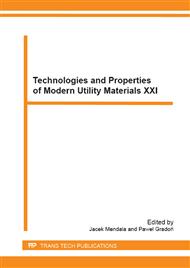p.215
p.221
p.225
p.229
p.237
p.243
p.247
p.255
p.259
Nucleation and Growth of Primary Silicon Crystals in AlSi Alloy after Modification with CuP and Overheating to a Temperature of 920°C
Abstract:
The article describes the process of crystallization of an AlSi17Cu5 (the A3XX.X series according to ASTM standard) alloy which has been modified with 0.05 wt. % P (CuP10 master alloy) and overheated to a temperature of 920°C. It has been shown that, so-called, "time-temperature treatment" (TTT) of alloy in the liquid state, which consists in overheating the alloy to a temperature above Tliq (about 250-300°C), holding at this temperature and rapid cooling, alters the morphology of primary silicon crystals. By the ATD method of thermal analysis, the characteristic temperature of crystallization (Tliq., TEmin., TEmax., TE(Cu), TE(Fe), Tsol.) were determined, and exothermic effects of the modifier and high-degree overheating on the crystallization course of the investigated alloy were examined. A new mechanism of proeutectic crystallization of the a(Al, Me=Cu, Fe) dendrites was proposed. The course of this process is dynamic enough to promote, due to local undercooling, the evolution of heat, which in the ATD curve appears as a well visible additional exothermic effect designated as TX. It is due to the presence in the liquid alloy of microregions with varied content of dissolved silicon.
Info:
Periodical:
Pages:
237-242
Citation:
Online since:
December 2013
Authors:
Price:
Сopyright:
© 2014 Trans Tech Publications Ltd. All Rights Reserved
Share:
Citation:


